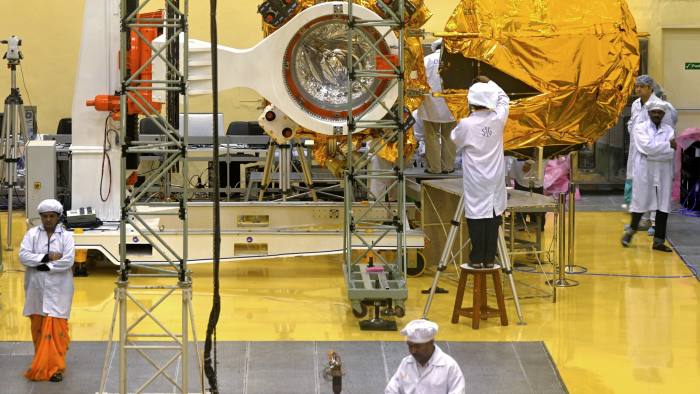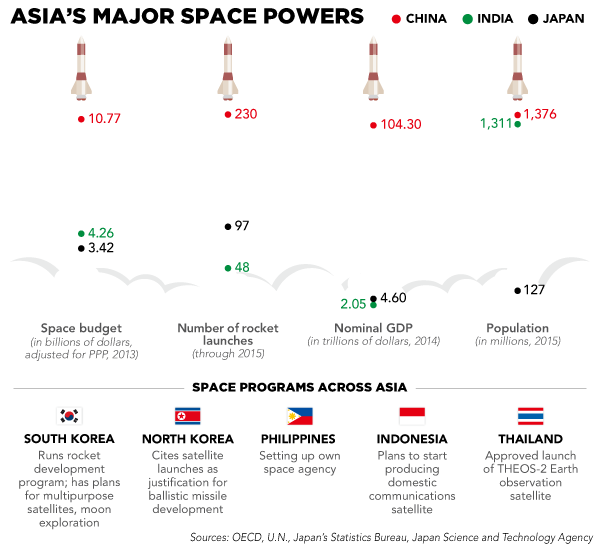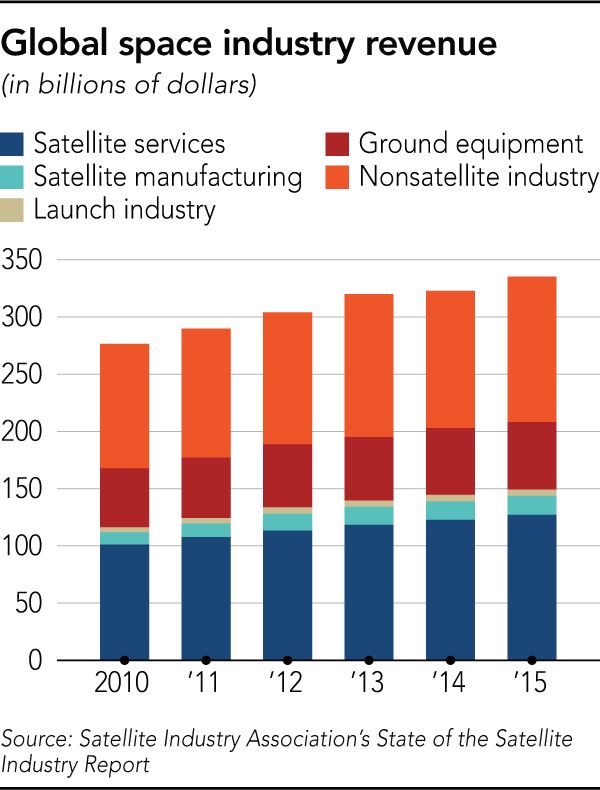By Go Yamada and Shuhei Yamada

A new space race is under way in Asia, with China and India duelling for dominance while other countries make leaps of their own.
National pride and defence are major motivators, but so are practical considerations — generating income from satellite launches, mitigating natural disasters and monitoring crops.
By establishing a presence in Earth’s orbit, and perhaps the expanse beyond it, governments and companies aim to ensure prosperity on the ground.
After India’s decision in November to scrap its largest bank notes, the picture on the back of the new 2,000-rupee replacement bill was surely the last thing on the minds of cash-strapped citizens.
The image, though, highlights a major national achievement and emphasises the country’s highest aspiration: to secure its place among the stars.
The note features a picture of India’s Mangalyaan probe, Asia’s first successful Mars orbiter. Launched in November 2013, the craft travelled around 670m kilometers and began circling the red planet the following September.
Prime Minister Narendra Modi lauded the mission in a televised address. “History has been created,” he said.
“We have dared to reach out into the unknown and have achieved the near impossible.”
Of course, India is hardly alone up there.
Regional rival China in 2003 became only the third nation in history to achieve manned space flight, after the former Soviet Union and the US.
Just as the 20th century space race pitted those Cold War rivals against each other, a 21st century race is picking up in Asia, with New Delhi and Beijing doing some serious jockeying.
The broad goals of enhancing national defence and gaining international prestige remain powerful motivators for reaching skyward.
But Asian countries also have specific, diverse and practical ambitions: to develop their own high-speed communications infrastructure, to explore for natural resources, to mitigate natural disasters and to snag satellite launch contracts from other nations.

In December, Indians saw just how valuable their space program can be.
As Cyclone Vardah bore down on the southern state of Tamil Nadu, the India Meteorological Department used data from the country’s weather satellites to project the storm’s path.
This prompted the evacuation of more than 10,000 people, saving untold lives.
Not a few Indians take advantage of the country’s satellites every time they turn on the television. Tata Sky, a direct-to-home satellite TV company launched in 2006 by Tata Group and 21st Century Fox, is capitalising on entertainment demand among the growing middle class, providing more than 400 channels.
It has a contract with the Indian Space Research Organization (ISRO) to use INSAT-4A, a national satellite system; it began 4K telecasts in January 2015.
India’s first satellite launch with its own rocket came in 1979.
It has since sent up 142 satellites aboard 59 rockets, including launches commissioned by other countries and unsuccessful attempts.
The pace has picked up in recent years, with 75 satellites launched on 24 missions since 2012.
The business of launching satellites for other countries is flourishing.
The ISRO has so far handled 79 satellites for 21 nations, including the US, Japan, Canada, Algeria and Indonesia.

India’s goal, according to the ISRO, is to use satellites for the benefit of society, though as with many space programmes, the defence factor cannot be ignored.
India’s endeavours have been closely linked to its development of long-range nuclear missile technology.
The late APJ Abdul Kalam — whose work on weapons earned him the nickname “Missile Man of India” and who also served as the country’s president — was once a member of the ISRO.
Satellites play a crucial role in military communications and missile guidance.
Remote sensing technology, which uses radar and high-performance cameras to observe the Earth’s surface, can be employed in spy satellites.
In any case, the programme hit a turning point in December 2014, when India fired off a prototype of the Geosynchronous Satellite Launch Vehicle Mark III — a large, advanced rocket that can carry a payload of eight tons into low Earth orbit and four tons into a high-altitude geostationary transfer orbit.
The maximum payload is 60 per cent greater than that for the GSLV-MK-II, previously India’s largest rocket in service.

Demand for communications, broadcasting, weather and Earth resources satellites is rapidly growing in emerging countries, where millions are signing up for cell phones and disaster preparedness is an ever-present challenge.
“Many countries, like South Korea and Saudi Arabia, are trying to launch their own satellites,” noted YS Rajan, honorary distinguished professor at the ISRO.
“With the GSLV-MK-III, India will be able to meet the requirements.”
Recent missions have shown the world what India can do.
Last June, it launched 20 satellites in one go — a national record.
In September, it pulled off the feat of launching eight satellites into two different orbits.
The ISRO is now preparing to launch 82 satellites in one mission. That would be a world record.
Low-cost launches are India’s forte.
The mission to Mars made this clear.
Launching the Mangalyaan cost $74m, about one-ninth the cost of the Maven, an American Mars probe.
The difference was thanks to domestic production, downsizing of parts and the decision to limit the equipment and functionality.
The Mangalyaan project also shows India harbors ambitions far beyond simply putting satellites in orbit.
It plans to follow up by launching a Mangalyaan-2 Mars probe in 2018.
Manned space missions are another possibility.
The launch of the Mark III prototype in December 2014 carried an unmanned crew module, which re-entered the atmosphere and splashed down in the Bay of Bengal, as designed.
Another leap came last May, when India launched and recovered its Reusable Launch Vehicle — a craft that resembles the Space Shuttle.
With the backing of Modi and other officials, the organisation’s budget has been increasing steadily. And engineers who once might have sought jobs in information technology are turning their attention to the heavens.
Some influential voices, however, question the wisdom of chasing national prestige.
“People prefer having rice to eat,” Mr Rajan said.
“A space program involves an enormous cost.”
Last year, ISRO Chairman AS Kiran Kumar said a manned mission “is not a priority at all.”
“Our priority,” Mr Kumar stressed, “is to build capacity for new [satellite] launches.”
Rather than trying to compete in manned space flight — a field in which China has a head start — it may be more realistic for India to focus on higher-performance satellites and probes.
Either way, the country’s space program bears watching.
China, meanwhile, continues to build on that head start, as it strives to become a “great space power”.
That is how Xi Jinping described Beijing’s goal in a ceremony at the Great Hall of the People on December 20.
The event was held to celebrate the successful launch of the Shenzhou-11 manned spacecraft in the autumn.
The craft ferried two astronauts to the Tiangong-2 space laboratory, where they stayed for 33 days — a record for China.
Xi said the mission “solidified the foundation” for achieving China’s ambition.
Experience gained during the sojourn should help in the completion of the Chinese space station, scheduled for 2022.
In the first half of this year, China is to launch its Tianzhou-1 cargo spacecraft — a stepping stone to transporting supplies to the space station.
Wu Yanhua, vice administrator of the China National Space Administration, said the aim “is to rank among the world’s top three by around 2030,” alongside the US and Russia.
On December 27, the government published a space development plan featuring missions to the moon and Mars.
Back in 2011, China entrusted Russia with the launch of a Mars orbiter, but the mission failed.
The country now plans to dispatch a craft to Mars on its own in 2020, including a rover that would explore the planet.
China also aims to develop technology for bringing back soil samples from the planet, and for asteroid exploration.
To the moon — where China soft-landed a craft in December 2013 — it intends to send another two unmanned probes.
The first, scheduled to land in late 2017, is to retrieve soil samples.
The second mission, expected in 2018, will be an attempt at the first soft landing on the far side of the moon.
China hopes to develop technology to communicate with that side through relay equipment.
As for sending humans to the lunar surface — something only the US has done so far — Mr Wu said China is looking into “various methods”.
Behind all of this are three main objectives.
- National prestige is one, as Mr Xi’s speech showed.
- Another is to prepare for a space war with the US — after all, China’s space programme is managed by the People’s Liberation Army.
- The third is to develop domestic industries and promote an economic realignment.
The BeiDou Navigation Satellite System, China’s answer to GPS, is expected to help with the third goal.
The system is to cover the whole globe, but especially countries tied to Beijing’s Belt and Road Initiative — its plan to develop infrastructure along routes connecting Asia and Europe.
Thirty-five satellites are expected to be operational by around 2020.
BeiDou is already providing location information services in 317 Chinese cities in China, and related businesses are expected to be worth a total of Rmb400bn ($58.1bn) by 2020.
Plus, offering an alternative to the US-led GPS could strengthen China’s international influence.
Like India, China is also pushing its satellite launch services, mainly through China Aerospace Science and Technology, a state-owned aerospace and defence company.
The country had launched more than 240 Long March rockets as of the end of 2016, boasting a 97 per cent success rate.
In 2016, it launched satellites for Spain, Uruguay and Belarus.
India and China are competing not just to impress the world or flex their military muscles, but to control the region’s communications infrastructure and reap the economic rewards of that dominance. Welcome to the new space race.

Aucun commentaire:
Enregistrer un commentaire